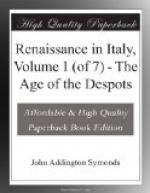During this age of the despots, Italy presents the spectacle of a nation devoid of central government and comparatively uninfluenced by feudalism. The right of the Emperor had become nominal, and served as a pretext for usurpers rather than as a source of order. The visits, for instance, of Charles IV. and Frederick III. were either begging expeditions or holiday excursions, in the course of which ambitious adventurers bought titles to the government of towns, and meaningless honors were showered upon vain courtiers. It was not till the reign of Maximilian that Germany adopted a more serious policy with regard to Italy, which by that time had become the central point of European intrigue. Charles V. afterwards used force to reassert imperial rights over the Italian cities, acting not so much in the interest of the Empire as for the aggrandizement of the Spanish monarchy. At the same time the Papacy, which had done so much to undermine the authority of the Empire, exercised a power at once anomalous and ill-recognized except in the immediate States of the Church. By the extinction of the House of Hohenstauffen and by the assumed right to grant the investiture of the kingdom of Naples to foreigners, the Popes not only struck a death-blow at imperial influence, but also prepared the way for their own exile to Avignon. This involved the loss of the second great authority to which Italy had been accustomed to look for the maintenance of some sort of national coherence. Moreover, the Church, though impotent to unite all Italy beneath her own sway, had power enough to prevent the formation either by Milan or Venice or Naples of a substantial kingdom. The result was a perpetually recurring process of composition, dismemberment, and recomposition, under different forms, of the scattered elements of Italian life. The Guelf and Ghibelline parties, inherited from the wars of the thirteenth century, survived the political interests which had given them birth, and proved an insurmountable obstacle, long after they had ceased to have any real significance, to the pacification of the country.[1] The only important state which maintained an unbroken dynastic succession of however disputed a nature at this period was the kingdom of the Two Sicilies. The only great republics were Venice, Genoa, and Florence. Of these, Genoa, after being reduced in power and prosperity by Venice, was overshadowed by the successive lords of Milan; while Florence was destined at the end of a long struggle to fall beneath a family of despots. All the rest of Italy, especially to the north of the Apennines, was the battle-field of tyrants, whose title was illegitimate—based, that is to say, on no feudal principle, derived in no regular manner from the Empire, but generally held as a gift or extorted as a prize from the predominant parties in the great towns.
[1] So late as 1526 we find
the burlesque poet Folengo exclaiming
(Orlandino, ii. 59)—




